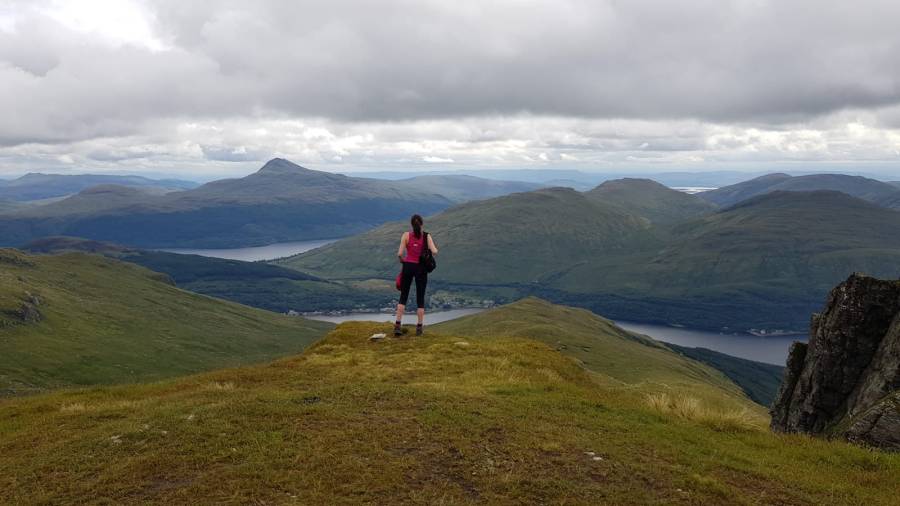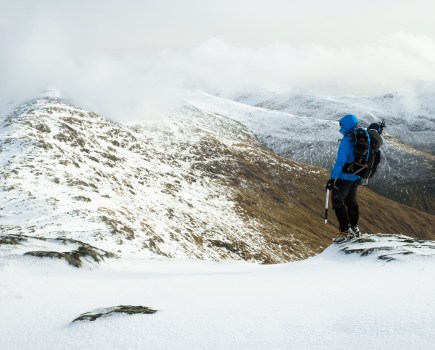Chiara Bullen asks if there’s enough education on how to deal with sanitary products on the mountains, and explores what alternative options are out there.
It was a grey and gritty day when my group of friends and I began climbing Ben Nevis for the first time. Nineteen years old and in the beginnings of a Munro-bagging frenzy, I felt like nothing could deter me. However, as we took in the welcoming views of the Halfway Lochan (Lochan Meall an t-Suidhe) a few hours later, I couldn’t shake the feeling that something was wrong. It wasn’t the rapid change of the weather without warning, nor was it the increasingly treacherous path. No – we had everything we needed to prepare for those. Waterproofs, spare gloves, maps, and some common sense when terrain became slippy and icy.
An hour or so later, as we stopped for a quick lunch, I headed off for some privacy, unable to ignore the stabbing pains in my lower abdomen any longer. Shortly after, my suspicions were confirmed. My period had decided to make an unexpected early arrival.
“Gritting my teeth, I prepared myself for the rest of our climb, thanking my decision to wear mostly black clothing”
Cold fear set in. I was climbing with a group of boys. A couple of the girls we’d come with had lagged behind and were with our slightly slower group – but would any of them have thought to bring a spare, emergency tampon in their packs? After all, I hadn’t. After a few hesitant seconds, I faced the grim reality – there was nothing I could do. Gritting my teeth, I prepared myself for the rest of our climb, thanking my decision to wear mostly black clothing (which included some absorbent sports leggings underneath my waterproofs).
Was that an uncomfortable read? It’s nothing compared to what I had to endure next. Popping a few paracetamols is all well and good, but I learned that the slopes of the UK’s highest mountain were not complementary to pain-relief efforts. As we stood in the midst of a blizzard, having triumphantly reached the summit, I longed for a hot-water bottle and for the pain to stop. Looking back at how I was one of the first to stride triumphantly to the trig whilst the group straggled behind me, the saying ‘anything you can do, I can do bleeding’ springs to mind.
Since then, I’ve found myself in a variety of similar situations: trekking along the Great Wall of China, and battling 50mph winds and blizzards in the middle of the Cairngorms. Luckily, I was prepared for these short, one-day trips, but it led me to thinking – what would I do if my time of the month fell during an expedition lasting days, weeks, or months?
“The arrival of an unexpected period can make troubling situations even worse.”
Scottish runner and hill-climber Grace Norman prefers to keep trips on the short side. “My period has never stopped me going on a hill walk, but it does make me double and triple check my bag for tampons and wipes and stuff. If I was planning a big day I would maybe modify the walk to make it shorter – but I’m quite fit and luckily my cramps aren’t too bad.”
Sometimes, the arrival of an unexpected period can make troubling situations even worse. “The worst climb I’ve had when it arrived was a revolting day in Glen Coe,” Grace explains. “We went scrambling but lost our visibility as the weather took a turn. In amongst this and 40mph winds, I got my period out of the blue. I was out for eight hours without any tampons.”
The plastic problem
For those who are lucky enough to never be caught unprepared, there’s the question of the added waste. It’s a matter of common decency that we take all litter home and leave the countryside untouched, but unfortunately not everyone complies. Human waste and litter have long since proven to be issues for the UK’s hills, and the BMC (British Mountaineering Council) has recently launched its ‘Hills 2 Oceans’ campaign to reduce litter on our mountains. Back in 2015, a staggering 153kg of rubbish was cleared from Ben Nevis – with used sanitary products prominent amongst the litter. On my own walks, I’ve seen the occasional tampon dangling from the branches of a bush or lying with scraps of rubbish. After my initial anger at this disdain for the ‘leave no trace’ approach, I wonder about the education around this topic for those with periods about how to handle them in the outdoors. Of course, common sense tells us to prepare for this by any means necessary. But when this isn’t the case (what hill climber hasn’t forgotten at least one, small thing they planned to help ease their journey?) then dealing with a used sanitary product can be challenging.
“I used organic non-applicator tampons a few years ago,” says Steph Davis, an American climber who has written openly about experiencing periods in the outdoors. “However I now use menstrual cups, which are the best things ever for the outdoors. I can usually go a whole day without having to change the cup.”
Menstrual cups – reusable, rubber or silicone cups inserted into the vagina during menstruation – have seen a spike in popularity as the movement against single-use materials advances, meaning that fewer used and non-recyclable sanitary products end up in our landfills and oceans. UK-based menstrual cup company Mooncup are tackling this waste whilst aiming to make a product comfortable enough to use during outdoor activities. “One person uses about 11,000 disposable sanitary products in their lifetime,” said Lucy Stewart, Marketing Assistant at Mooncup. “The Mooncup lasts years and greatly reduces this. Many Mooncup users use the cup for outdoors activities – anything from swimming to mountain hiking.”
Tips for hillwalking on your period
Regardless of what method you decide to go with, the consensus for walkers with periods is to always keep an ‘emergency stash’ no matter when in your cycle you end up out and about. “I think it’s a good idea to keep a tampon or menstrual cup in your pack lid in case of surprises, as well as extra painkillers,” says Steph Davies.
“If you get your period on the hills, I definitely recommend the zip-lock bag approach for used products. We should leave the countryside untouched,” adds Grace Norman. The zip-lock bag approach is as simple as it sounds – carrying a spare zip-lock in your bag for used sanitary products to prevent spillage and contamination of any food supplies until you can dispose of them safely. Doubling up is recommended.
It’s also a good idea to keep unscented wet wipes accessible, and some hand sanitiser to keep your hands clean. Even with menstrual cups, you might be faced with disposing of the contents when out and about. In this case, it’s recommended you dig a 6–8-inch-deep cathole (a small hole) to do so, well away from water sources and other people.
To learn more about the Leave No Trace campaign – for menstrual products or otherwise – head to lnt.org







